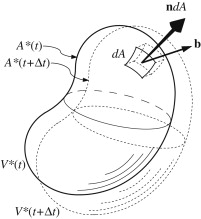From Leibniz's Theorem to the Reynolds Transport Theorem

Geometrical depiction of a control volume \( V^*(t) \) having a surface \( A^*(t) \) that moves at a nonuniform velocity \( \mathbf{b} \) during a small time increment \( \Delta t \).
When \( \Delta t \) is small enough, the volume increment \( \Delta V = V^*(t+\Delta t) - V^*(t) \) will lie very near \( A^*(t) \), so the volume-increment element adjacent to \( dA \) will be \( (\mathbf{b} \Delta t) \cdot \mathbf{n} dA \) where \( \mathbf{n} \) is the outward normal on \( A^*(t) \).